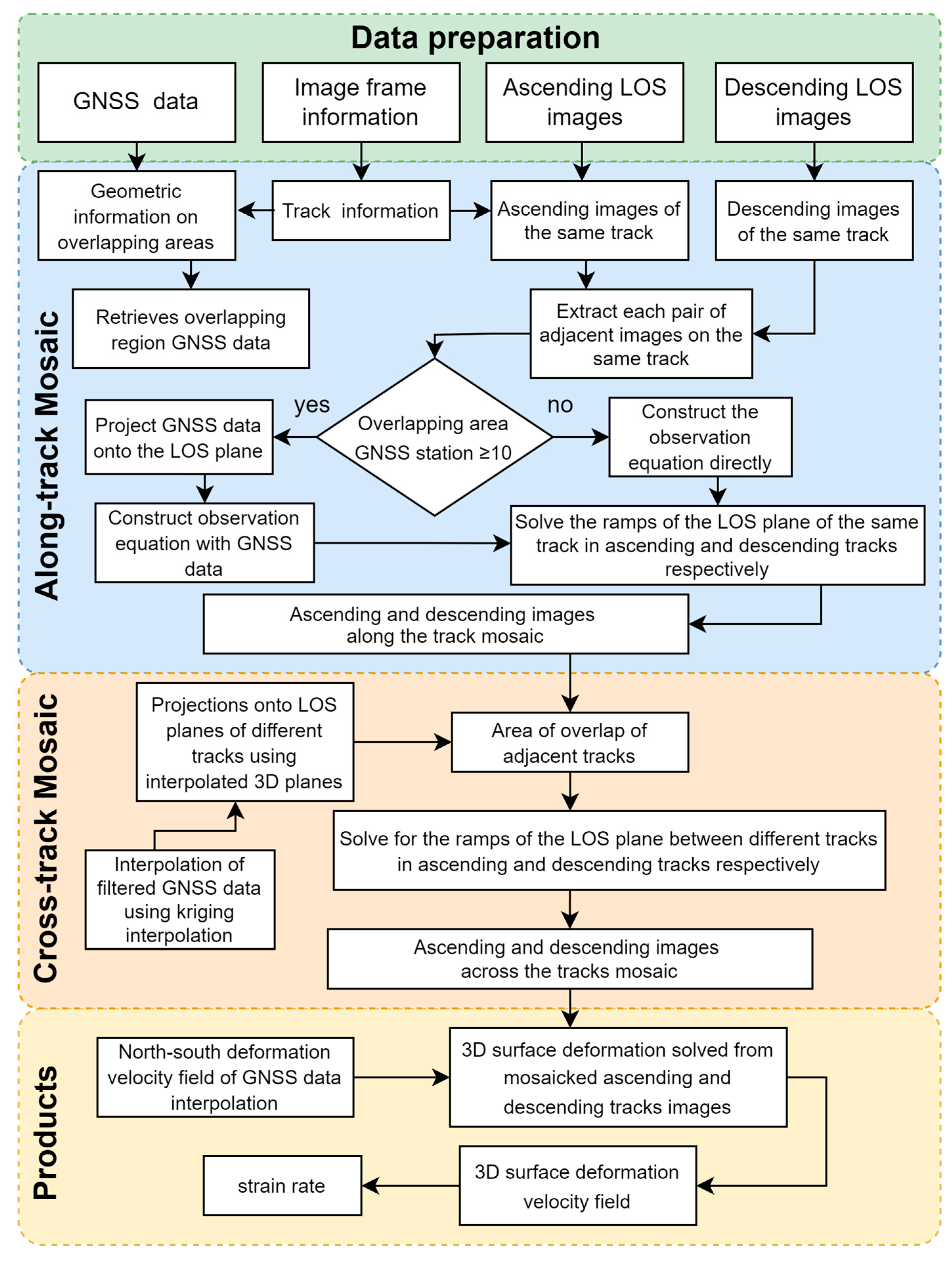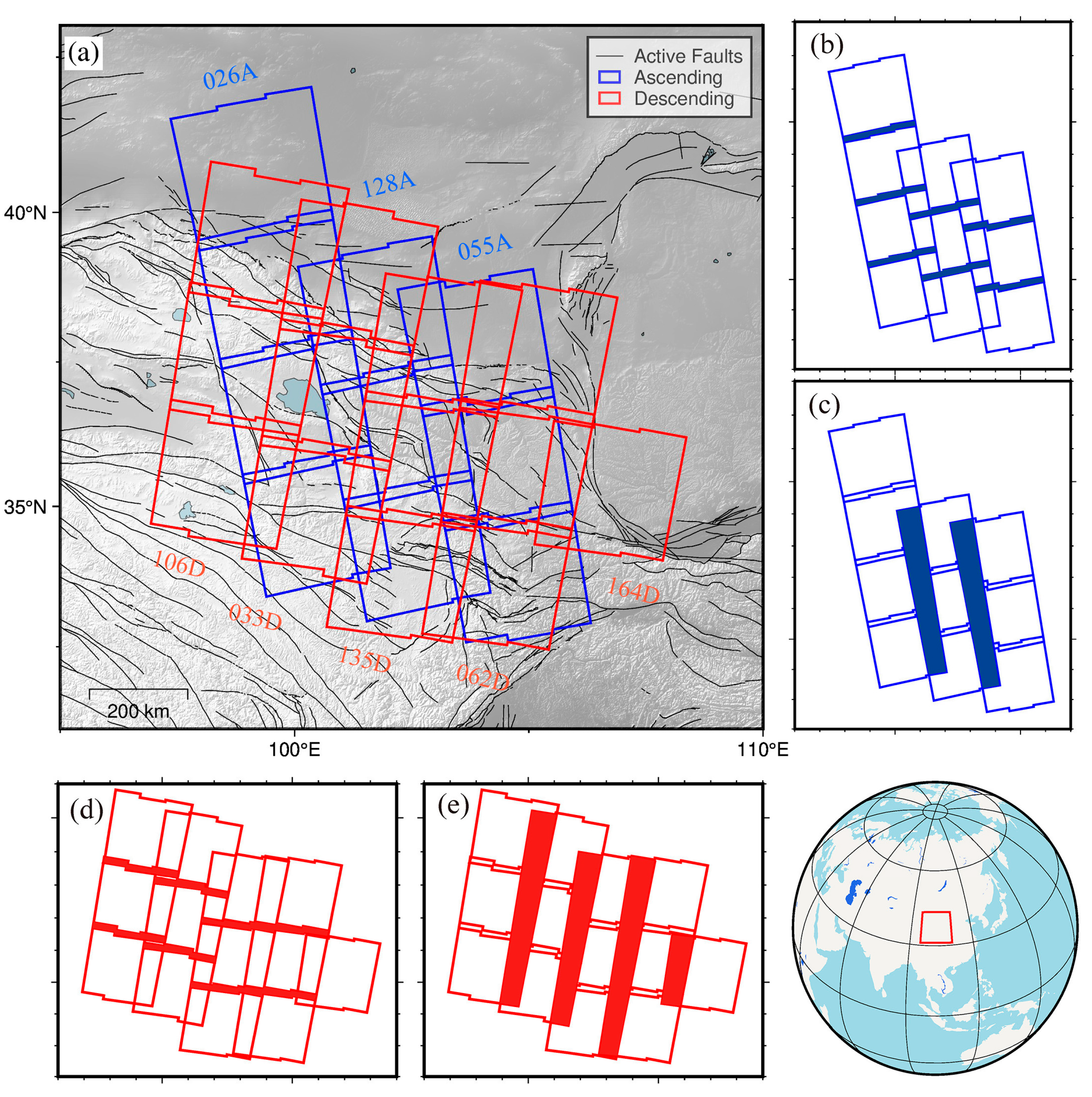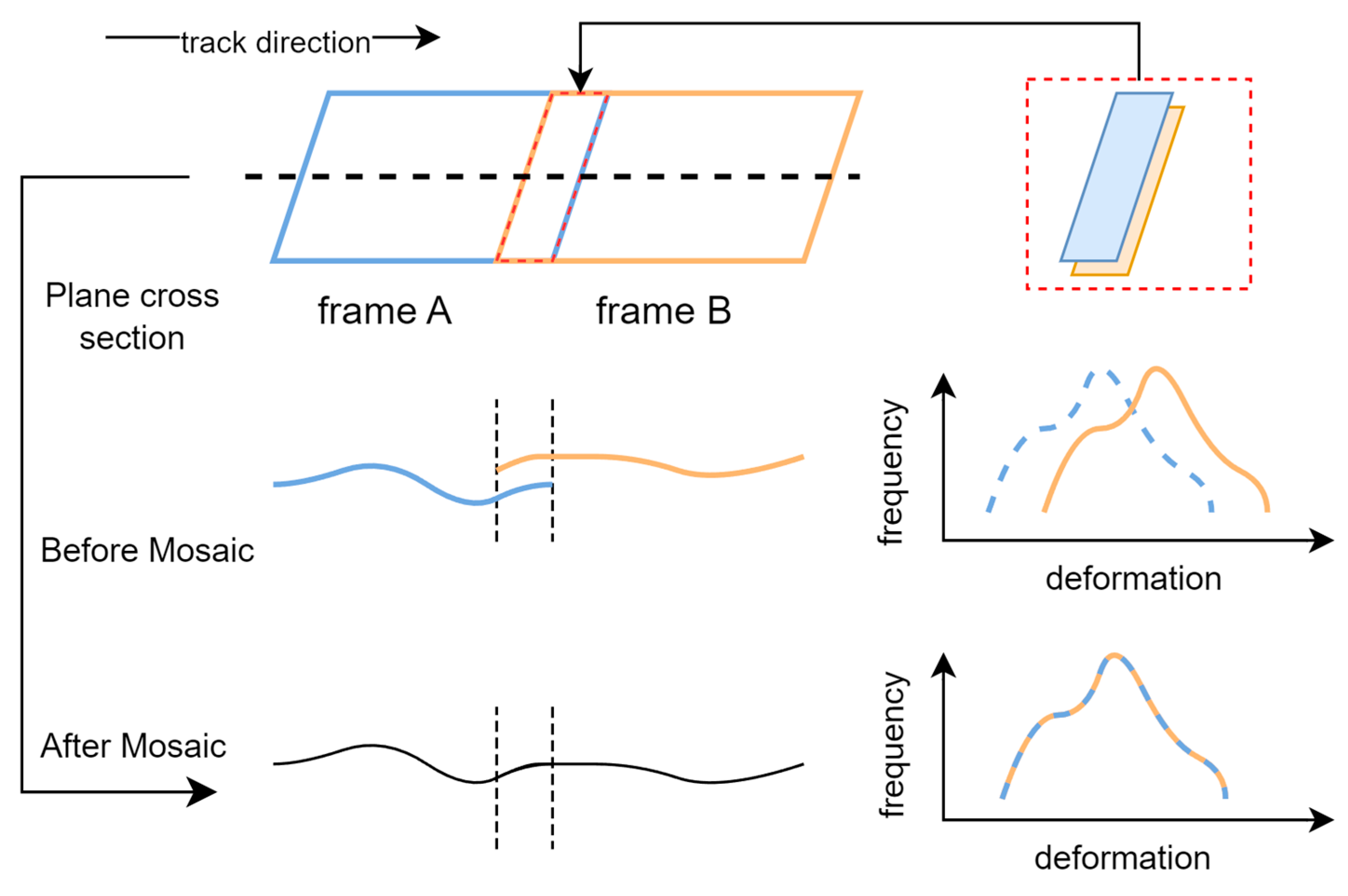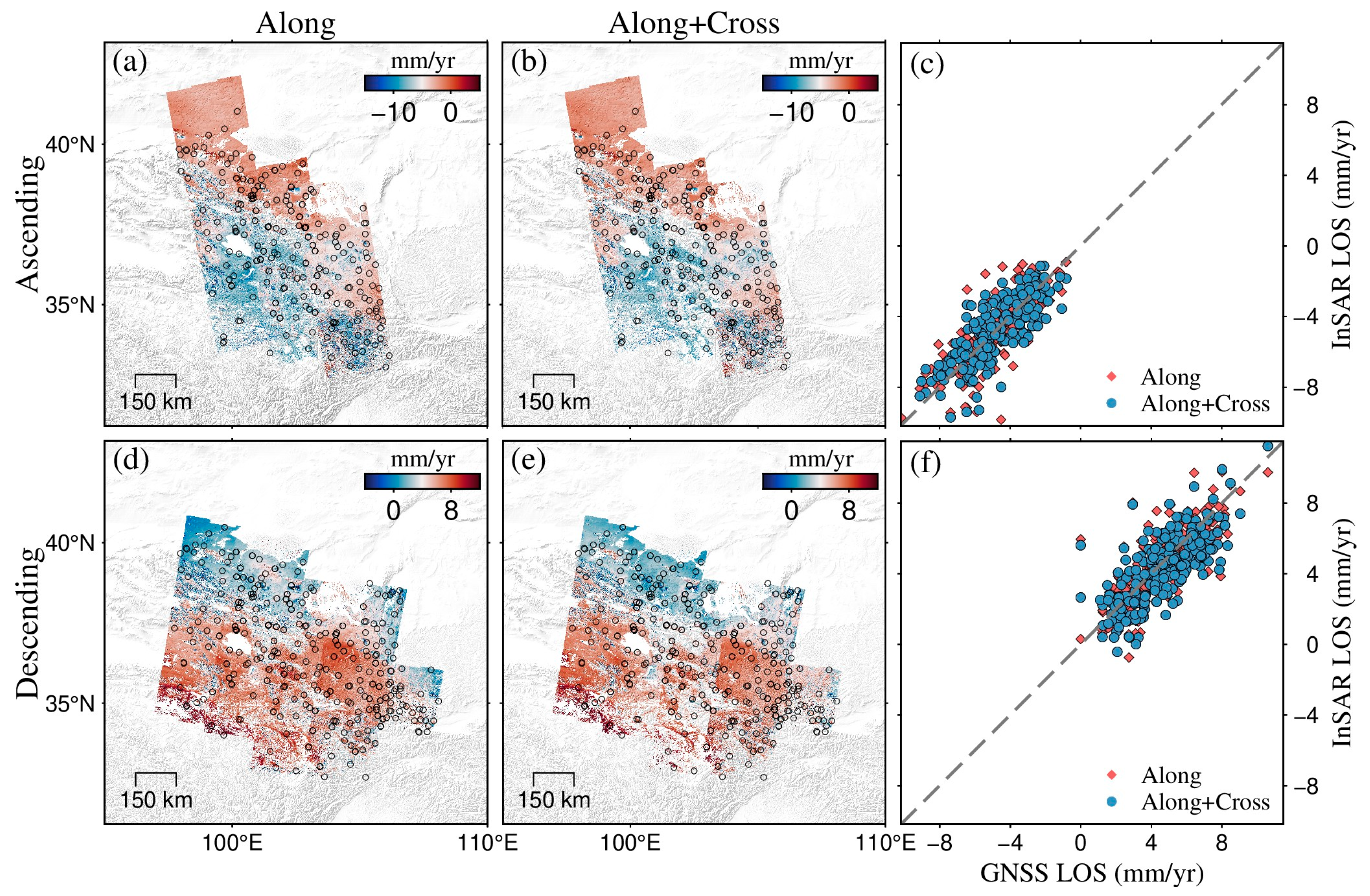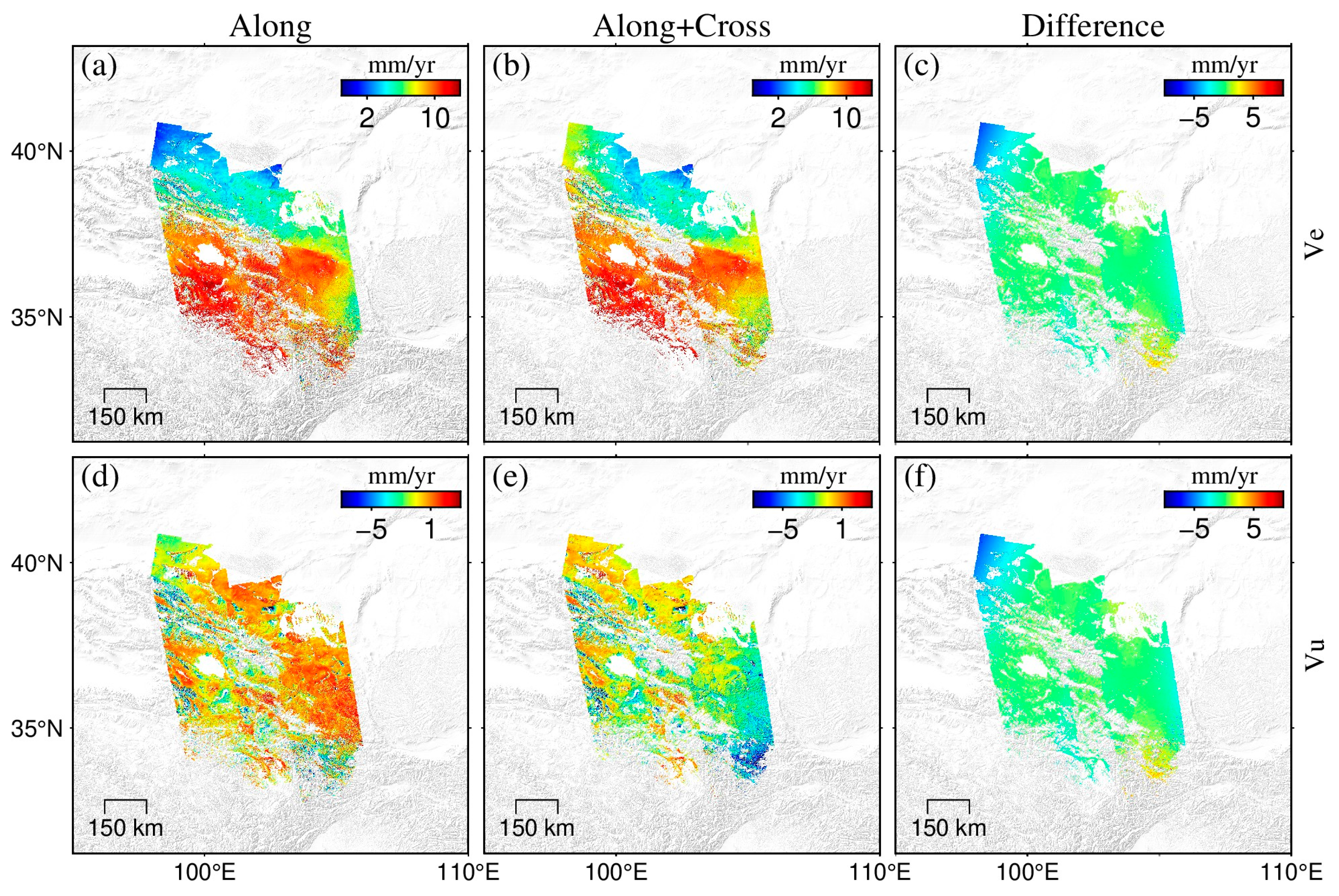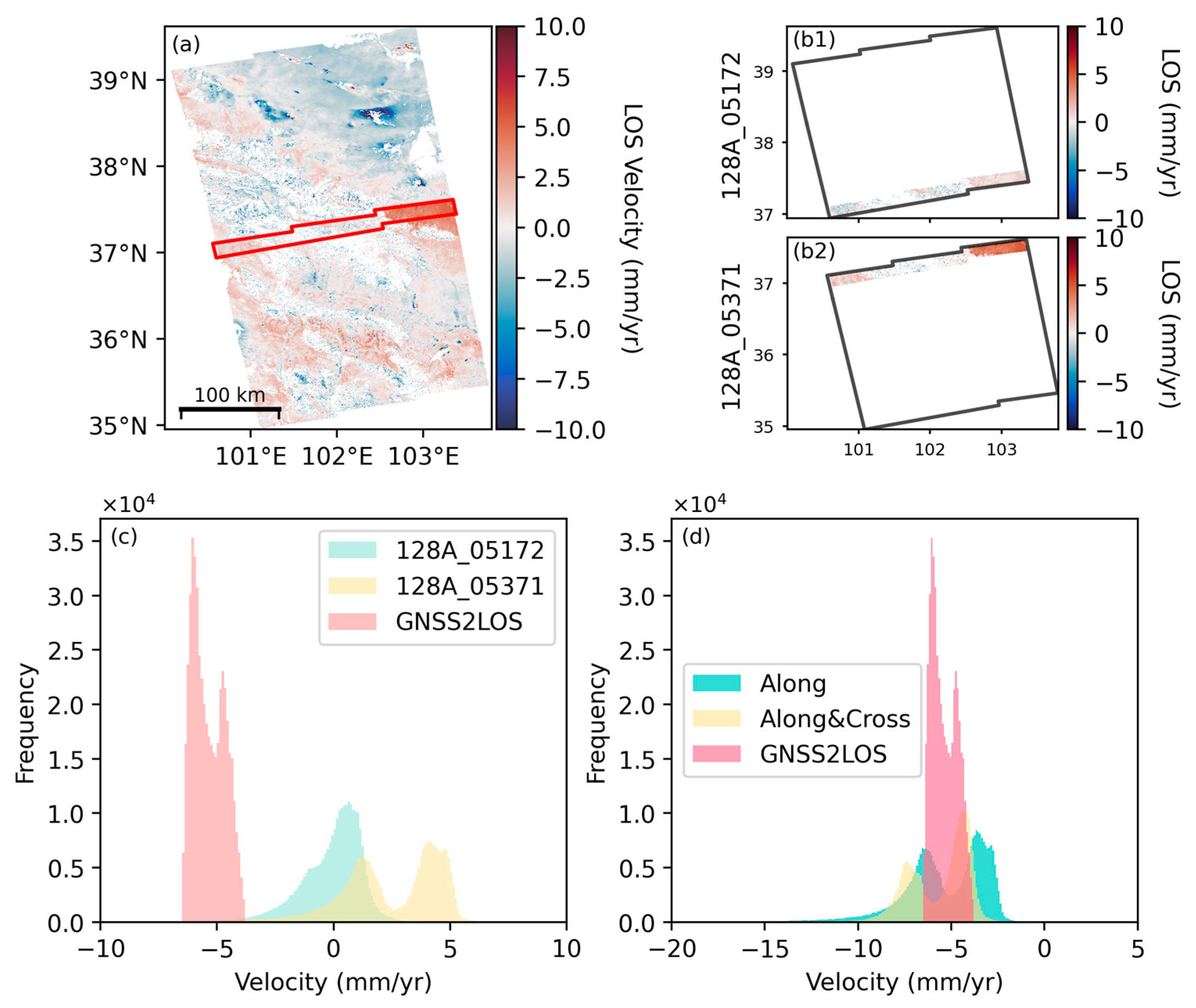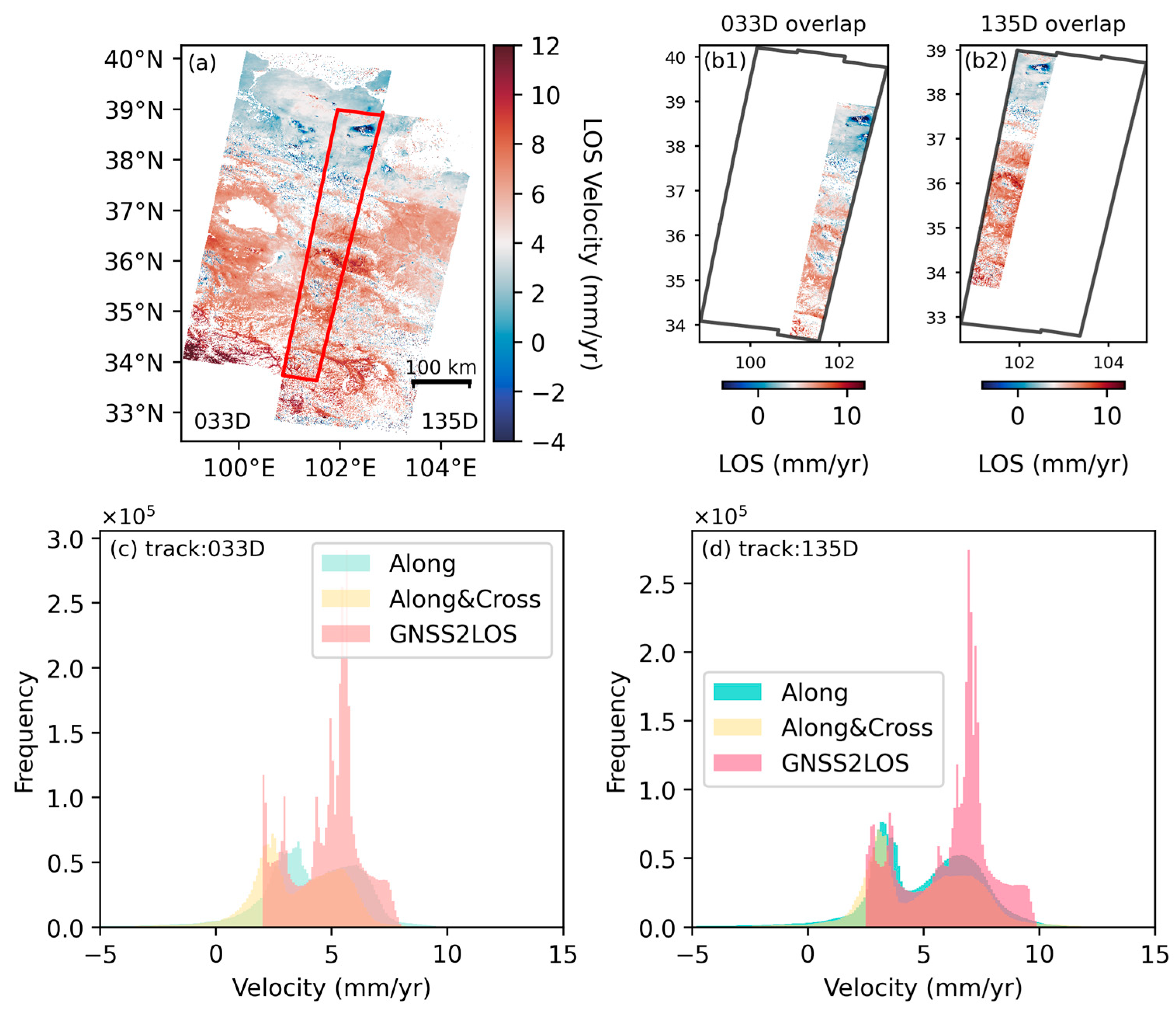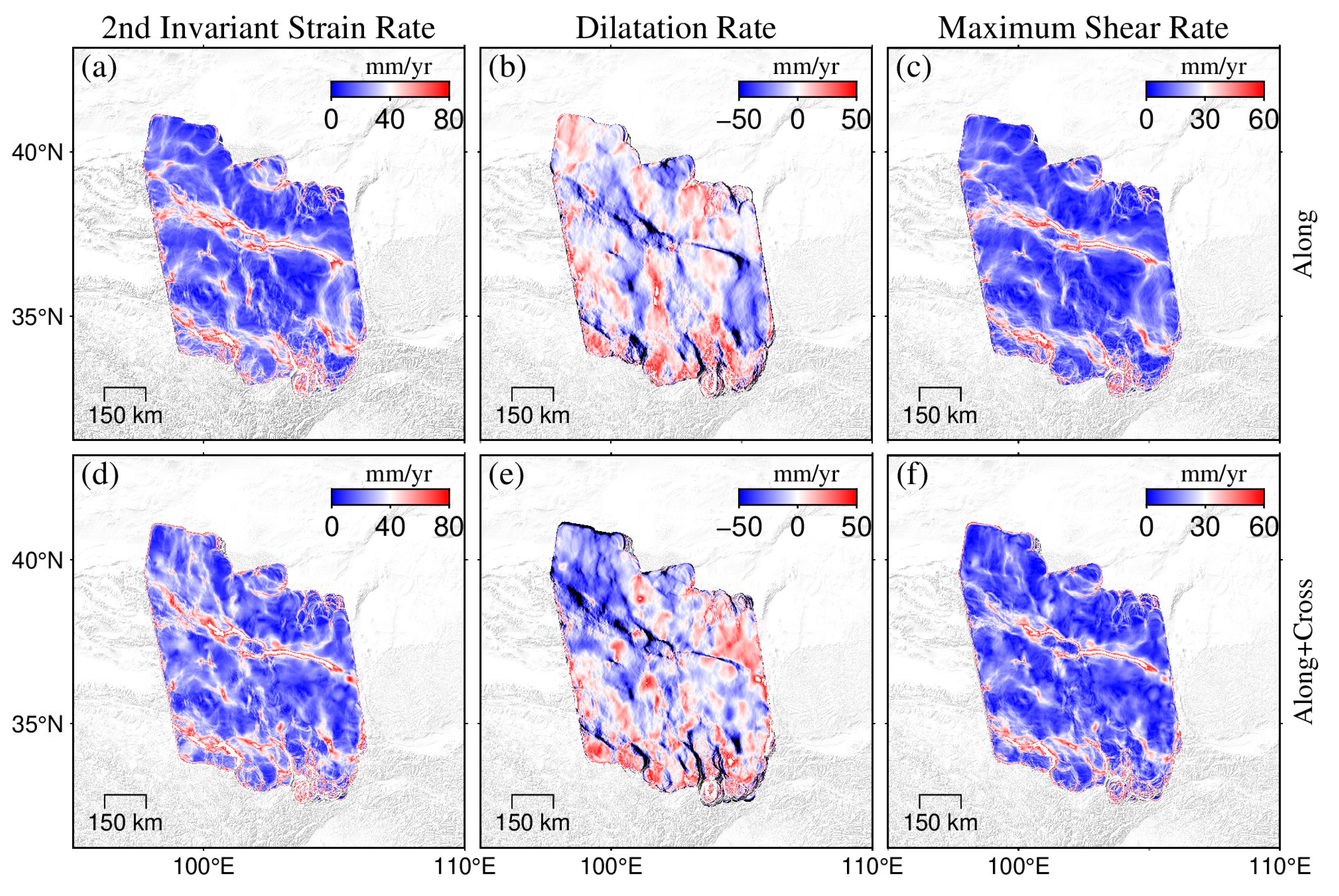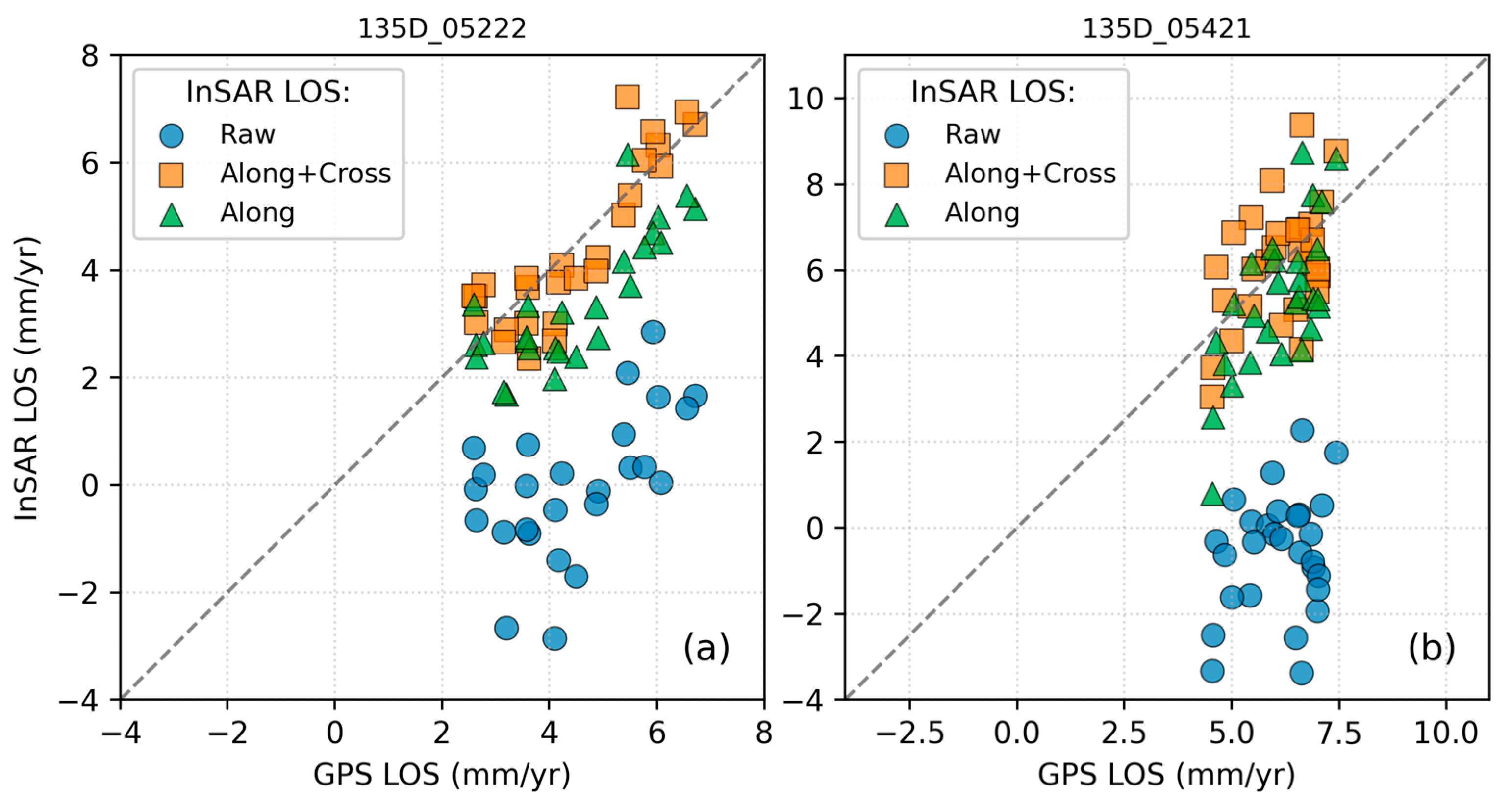1. Introduction
In recent decades, Interferometric Synthetic Aperture Radar (InSAR) has become a valuable technology for monitoring crustal deformation across continents [
1,
2,
3,
4,
5]. This radar technique enables the measurement of ground movement with millimeter-level precision [
6] and offers spatial resolutions in the tens of meters [
7]. Consequently, InSAR provides continuous observations over large areas, making it an essential tool for regional tectonic studies [
8,
9,
10].
Surface deformation serves as a fundamental indicator of various geological hazards, including their initiation and evolution. By analyzing surface deformation data, strain rates can be calculated, which are then used to estimate surface deformation events. An efficient approach involves analyzing three-dimensional (3D) surface deformations. Precise geodetic estimations of ground-surface velocities and strain rates are crucial for understanding localized seismic hazards and the distribution and mechanics of deformation across the ground [
11,
12,
13].
In automated processing of extensive, high-resolution InSAR data, two primary methodologies are widely adopted. The first approach, akin to that proposed by Thollard [
14], involves processing InSAR data along a long track and then combining these images. To enhance visual continuity across segments, a constant velocity was added to each image, covering the study area—this process demands substantial high-performance computing power.
Conversely, the second approach partitions the study area into smaller blocks for batch processing. This process begins by processing individual observational frames to generate corresponding products. These products are then aggregated to provide comprehensive coverage of the study area. A joint analysis of these multi-frame outputs then yields the final results. As a quintessential example of this methodology, the LiCSAR project enables users to efficiently select frames corresponding to the designated study areas [
15]. This approach is designed to manage large-scale InSAR data within the constraints of computational resources, memory, and storage. However, this approach presents a significant challenge: when multiple images are used to cover the study area, overlapping regions inevitably occur between frames. Resolving these overlaps while ensuring image coherence is particularly difficult. These overlaps often result in substantial mismatches during mosaicking of line-of-sight (LOS) velocity frames, as reported by [
16]. InSAR data covering urban areas across Japan were processed by [
17]; multiple ascending and descending LOS velocity frames were utilized to derive surface deformation information in urban settings. InSAR data from the eastern Tibetan Plateau were analyzed by [
18], with Global Navigation Satellite System (GNSS) data incorporated as constraints for mosaicking along-track LOS velocity frames and performing 3D surface deformation inversion, ultimately leading to the derivation of a strain rate map for the entire study area. InSAR images of the Altyn Tagh Fault were processed by [
19] to obtain velocity field data; GNSS and sampled InSAR velocities were jointly inverted during the mosaicking of cross-track LOS velocity frames, resulting in the estimation of the 3D surface deformation field. Conventional InSAR mosaicking methods [
18,
19,
20,
21] depend on simplistic assumptions of satellite azimuth and incidence angle continuity, often compromising geometric specificity through spatial smoothing. Our approach advances the field in two critical ways. First, we retain the full LOS geometric fidelity of individual acquisition geometries, ensuring the structural integrity of strain tensor data across overlapping swaths. Second, our multi-source fusion framework addresses the sparse GNSS constraint limitation inherent to traditional velocity mosaicking—where deformation modeling relies primarily on discrete GNSS measurements—by incorporating an interpolated GNSS-derived deformation surface as a continuous boundary condition. These innovations enable geometry-aware data fusion: LOS-centric mosaicking preserves directional deformation components typically attenuated by azimuthal averaging, while GNSS surface interpolation establishes spatially continuous geodetic constraints that improve model reliability in areas with sparse GNSS coverage. Consequently, our method resolves the inherent compromise between geometric specificity and physical consistency plaguing conventional techniques, offering a framework for deformation analysis that is both geometrically precise and physically robust.
Building on prior methodologies, we implemented the along-track mosaicking technique developed by [
18,
21], integrating GNSS station data from overlapping regions and projecting them onto the LOS direction to minimize interframe discrepancies. For cross-track mosaicking, we enhanced conventional methods by methodically incorporating all available GNSS data across the study area. Notably, we employed Kriging interpolation to construct the 3D deformation field in overlapping regions due to its dual strengths: (1) explicit modeling of spatial autocorrelation via variogram analysis, preserving localized deformation trends [
22], and (2) superior validation performance, reducing interpolation errors by approximately 5% compared to Inverse Distance Weighting (IDW) (
Table S3). The interpolated field was then projected onto LOS directions to resolve cross-track discrepancies [
23].
Kriging is prioritized over alternative methods for its geostatistical rigor in addressing spatially correlated deformation signals—essential for tectonic or subsidence studies where deformation gradients exhibit directional dependencies. Although Kriging’s Gaussian process assumptions may suppress high-frequency deformation signals in data-sparse areas, our workflow mitigated this limitation through GNSS station density optimization and post-interpolation residual analysis. Empirical validation confirmed that Kriging’s ability to quantify interpolation uncertainty offers a quality control mechanism absent in deterministic approaches like IDW.
Our framework minimizes mosaicking errors bidirectionally by integrating along-track GNSS anchoring with cross-track Kriging-optimized fusion, enhancing the accuracy of 3D deformation rate estimations and strain field refinement. This study advances large-scale InSAR velocity mosaicking by resolving the trade-off between spatial continuity (achieved via Kriging’s stochastic interpolation) and geometric specificity (maintained through LOS-constrained fusion), establishing an error-aware standard for InSAR–GNSS integration.
2. Methodology
When visualizing the LOS deformation velocity field data from the same track type on a single map, discontinuities are observed in the overlapping regions between adjacent frames, resulting in non-smooth transitions. This indicates the presence of errors within the individual frames, rendering the direct inversion of the 3D deformation field unsuitable. Consequently, it is essential to correct the LOS deformation velocity field frames by leveraging the information from overlapping regions, followed by the mosaicking process, before performing the inversion. This methodological refinement ensures the accurate reconstruction of large-scale 3D deformation fields.
During the frame mosaicking process, we need to minimize the constant offsets between frames caused by local reference effects and the track’s overlap offsets induced by changes in the incidence angle [
24]. At the same time, we must limit the errors introduced by the interferogram processing. Therefore, for an individual frame, we simplify the observation equation for the LOS values as follows:
Here,
represents the processed LOS deformation velocity data obtained from the observed data, while
denotes the true value data without errors.
N represents the random errors introduced during the processing of the LOS deformation in a single frame within the same track, and
S refers to the inherent errors associated with the track.
Due to the inconsistency of local references between frames, there must be a ramp between two adjacent frames [
25]. The frame mosaicking process involves eliminating this ramp. Therefore, for two adjacent frames, the difference between their observation equations in the overlapping region can be described as:
represents the errors introduced during the processing of LOS deformation, including the constant offsets between frames caused by local reference differences and errors arising from interferogram processing, and
denotes the long-wavelength errors between tracks, specifically the tracks’ overlap offsets induced by changes in the incidence angle.
We divided the frame mosaicking process into two steps: first, mosaicking along the track, and then mosaicking across tracks. For mosaicking along a track,
and
should be equal after correcting for local references, and
and
are also equal since they are on the same track. Therefore, the above equation can be simplified as:
Here,
. By calculating the difference between each pixel in the overlapping region, we can determine this ramp. However, there are still some limitations; specifically, the reference frame of the LOS images inherently contains errors. As a result, even after eliminating the ramp, there may still be offsets. Therefore, we introduced GNSS observations to correct these offsets. When GNSS observations were available in the overlapping region, we projected the GNSS data onto the LOS direction using the following equation:
Here,
represents the GNSS data projected onto the LOS direction;
and
correspond to the satellite azimuth and incidence angle of the InSAR image at the geographic location of the GNSS data, respectively.
,
, and
represent the 3D deformation velocities measured by GNSS in the east, north, and up directions, respectively.
By projecting the GNSS data, we can obtain a fixed reference plane, which allows the two frames to be aligned with this reference plane. As is well known, GNSS data are sparse. For overlapping regions without GNSS data, an effective approach is to smoothly approximate the average plane between the two frames. Simple methods for this process are provided in [
26], such as using polynomial fitting to define a plane or applying a convolution function to create a smooth transition region. These mathematical algorithms for image processing result in a visually pleasing mosaicking of the frames, but they also introduce non-negligible errors. We applied an improved algorithm based on [
18,
21] for mosaicking frames along the track. This approach considers the uncertainty
of the GNSS data projected onto the LOS direction and is determined by the following equation:
Here,
and
represent the uncertainties in the eastward, northward, and vertical deformation velocity data, respectively, obtained from GNSS measurements.
If we do not project the GNSS data onto the LOS direction and instead consider the GNSS-observed 3D deformation as the true surface deformation, the ramp between the two frames can be calculated using the following equation:
Here,
represents the LOS deformation velocity value for a given pixel in the overlapping region of one frame, while
represents the LOS deformation velocity value for the corresponding pixel in the other frame. The
,
,
, and
correspond to the satellite azimuth and incidence angles of the respective InSAR images.
,
, and
represent the eastward, northward, and vertical surface deformation velocities.
and
are the coordinates of the i-th points;
a,
b, and
c are the model factors used to determine the linear plane for each track.
Since the true 3D surface deformation is an unknown parameter that cannot be directly obtained, and the GNSS measurement data also contain random errors, we can eliminate the related parameters by taking the difference between the two frames. Since the azimuth and incidence angles are the same at the same location, the following equation can be used to solve for the ramp:
For cross-track mosaicking, the difference between the two types of observations in the overlapping region of two adjacent frames can be described as:
Here,
. Due to the long-wavelength errors between tracks and the tracks’ overlap offsets caused by changes in the incidence angle,
cannot directly yield a fixed ramp [
27]. Consequently, by interpolating three planes utilizing GNSS data and subsequently projecting them into two tracks’ directions, we can obtain two sets of track data projected by distinct GNSS systems. By subtracting these two datasets, we can derive the value of
. Hence, Equation (7) can be reformulated as follows:
where
,
represents the projection of GNSS data onto the m track, and
represents the projection of GNSS data onto the n track.
The GNSS reference calibration is the solution of the weighted least squares parity, which is given by the following equation:
where
represents the LOS velocity value at the i-th point in the overlapping area;
denotes the velocity value of the GNSS projection onto the LOS direction at the i-th point;
represents the measurement uncertainty of the GNSS projection onto the LOS direction at the i-th point. For the i-th point,
and
are its coordinates, while a, b, and c are the fitted model factors used to determine the linear plane for each mosaicking frame.
Dealing with overlapping pixels on multiple trajectories is represented by the following equation:
where
represents the track-specific offset value, which is calculated from the interpolated data and the velocity field of LOS.
The weights are determined by
The processing procedure is structured in two stages. First, along-track processing involves aligning the LOS velocity field to the GNSS reference frame using GNSS station data within the frame. Subsequently, the along-track frames are iteratively adjusted by enforcing consistency in overlapping region values for the same track. Second, cross-track processing addresses discrepancies in cross-track overlapping regions. Here, track information is corrected using interpolated GNSS data, followed by a secondary refinement of the LOS velocity field through the integration of relative displacement fields between adjacent tracks. Finally, the overall experimental process of this study is shown in
Figure 1.
3. Validation Tests of the Methods in This Paper
We utilized the preliminary processed LOS deformation velocity field from [
18], derived from 23 Sentinel-1 images collected across 9 ascending tracks and 10 descending tracks. Overlaps existed between adjacent frames along a track and among multiple frames of adjacent tracks. As illustrated in
Figure 2b,c represent the frames corresponding to ascending tracks, with the blue blocks indicating the overlapping regions of along-track and cross-track data, respectively.
Figure 2d,e correspond to frames from descending tracks, with the red blocks representing the overlapping areas of along-track and cross-track data, respectively.
This study focused on the mosaicking of large-scale LOS deformation velocity fields, structured into two distinct phases: along-track mosaicking and cross-track mosaicking. For the along-track mosaicking, we initially applied the methodology outlined in [
18] to preprocess 23 LOS velocity fields, each covering an area of 250 km × 250 km. Subsequently, we determined the corresponding uncertainty and azimuth data and extracted the 3D GNSS deformation velocity information from [
28,
29]. Finally, using the collected data, we implemented the along-track mosaicking model to integrate the LOS velocity fields from each track, thereby generating the mosaicked along-track LOS deformation velocity field.
During the along-track processing phase, the LOS velocity field was calibrated to the Eurasian GNSS reference frame using GNSS station data from overlapping regions. This calibration employs satellite incidence angles and azimuths to project GNSS-derived deformation velocities onto the LOS direction. Adjacent LOS velocity frames were then iteratively refined via planar alignment, ensuring spatial consistency with the fixed GNSS reference frame and removing planar ramp distortions. For overlapping regions, pixel-wise difference analysis between corresponding pixels in paired LOS velocity fields identified discrepancies. The average difference was applied as a ramp correction, guided by the theoretical principle of spatial coherence for velocity fields along the same track.
During the mosaicking process along the track, the deformation values of the overlapping areas of two adjacent frames changed from different deformation values to equal values. In
Figure 3, the detailed outcome of the mosaicking operation along the track is presented.
The subsequent step involved employing the Kriging interpolation method to process the GNSS east–west and north–south deformation velocity data, considering only data points with an uncertainty below 0.7 mm/year. Initially, we conducted interpolation on both the east–west and north–south deformation fields at a reduced resolution across the study area. Following this, we applied a nearest-neighbor interpolation method to resample these deformation fields, ensuring they align with the resolution of the imagery. Given the limited availability of GNSS measurements in the vertical direction, we did not impose a threshold, thereby allowing all vertical deformation data to contribute to the Kriging computation. The resulting vertical deformation velocity field was also resampled to achieve consistency in resolution.
In the third step, we integrated the LOS deformation rate data from the long tracks, together with the incidence angle and azimuth data, as well as the interpolated east–west, north–south, and vertical deformation velocity fields derived from GNSS data. Utilizing a cross-track mosaicking model, we estimated the ramp discrepancies between long tracks and subsequently eliminated these discrepancies to reassess errors in the LOS deformation velocity data for each long track. Finally, we mosaicked the long-track data corrected for ramp effects to generate the LOS deformation velocity field for both ascending and descending tracks across the entire study area.
In the cross-track processing phase, a two-stage correction strategy resolved discrepancies in cross-track overlaps. First, track-specific errors were minimized by interpolating GNSS data to address spatial gaps. Second, the LOS velocity field underwent secondary refinement by integrating relative displacement fields between adjacent tracks, improving coherence and reducing systematic biases across the observation network. In the cross-track mosaicking process, the deformation values in the overlapping areas of two adjacent frames gradually converged from initially large discrepancies. In
Figure 4, the detailed results of the cross-track mosaicking process are presented.
Upon completing the mosaicking of the velocity field for the study area, we recognized that InSAR data exhibited insensitivity to north–south deformation [
30]. Consequently, we integrated the ascending and descending tracks’ data with the interpolated north–south GNSS deformation velocity field data to facilitate the inversion of the 3D deformation rate of the surface within the study area. Subsequently, we computed the horizontal strain rate based on the two-dimensional velocity field.
In this processing phase, we aimed to obtain the horizontal dilatation rate map, the maximum shear rate map, and the second invariant of the horizontal strain rate. To ensure meaningful variations and smooth transitions, we employed the interpolated north–south velocity field derived from the GNSS data, along with the east–west velocity field obtained using a 60 km sliding median filter. Additionally, Gaussian filtering was applied to the north–south velocity field, with the sigma parameter set to 2 pixels, to improve the smoothness of the velocity field. This technique was instrumental in mitigating the influence of data points with abrupt variations in strain rate over a minute range, thereby accentuating the effects of strain rate changes across a more extensive range.
4. Results
In this study, we conducted a systematic evaluation of two strategies for mosaicking InSAR LOS images: along-track mosaicking exclusively and the combined approach of along-track and cross-track mosaicking. The effects of these methodologies are illustrated in
Figure 5, which depicts the differences observed under both ascending and descending track conditions.
First and foremost, it is essential to comprehend that the LOS deformation of each track existed within distinct planes. The final outcome of the mosaic revealed disparities in the LOS deformation planes associated with each track. As illustrated in
Figure 5a,b,d,e, whether utilizing the Along mosaic or the Along+Cross mosaic, it was possible to achieve a relatively seamless transition of the LOS deformation values within the overlapping areas of the same track. Nevertheless, significant differences persisted among various tracks, particularly noticeable at the edges of the central tracks within the study area, where abrupt mutations occurred. This phenomenon arose due to the differing planar azimuth and incidence angles of two adjacent tracks, culminating in intrinsic step changes.
Figure 5c,f demonstrate the comparative performance of the Along and Along+Cross methods in processing the LOS deformation velocity field. The horizontal axis represents GNSS-derived LOS velocities, while the vertical axis corresponds to the mean velocity of all pixels within 500 m buffer zones centered on GNSS stations. The Along+Cross method achieves a marginal improvement in accuracy. For instance, in
Figure 5c, blue markers (Along+Cross) exhibit tighter clustering along the y = x reference line compared to red markers (Along), with reduced deviation magnitudes quantifying the enhanced alignment of the LOS velocity field. This pattern persists in
Figure 5f, where the Along+Cross results show superior agreement with projected GNSS velocities. The proximity of data points to the y = x line directly reflected the efficacy of each processing methodology, with the Along+Cross approach consistently minimizing systematic biases.
Figure 6 and
Table S1 demonstrate marked improvements in surface deformation monitoring accuracy achieved by the Along+Cross method compared to the traditional Along method.
Table S1 summarizes cross-track validation results: For Track 055A, the root mean square error (RMSE) decreased from 3.33 mm/yr to 3.20 mm/yr (Δ = 0.13 mm/yr, a 3.93% reduction), while Track 164D improved from 3.29 mm/yr to 3.16 mm/yr (Δ = 0.12 mm/yr, 3.80%). Notably, Track 135D exhibited the most substantial improvement, with RMSE declining sharply from 2.45 mm/yr to 1.70 mm/yr (Δ = 0.74 mm/yr, 30.31% reduction).
An analysis of additional tracks’ datasets confirmed broad applicability: Track 106D decreased from 2.22 mm/yr to 2.03 mm/yr (Δ = 0.18 mm/yr, 8.23%), Track 062D decreased from 1.80 mm/yr to 1.68 mm/yr (Δ = 0.11 mm/yr, 6.49%), and Track 128A decreased from 1.66 mm/yr to 1.59 mm/yr (Δ = 0.07 mm/yr, 3.97%). Error reduction magnitude correlated strongly with initial error values (R2 = 0.86), with Track 135D’s outlier performance suggesting disproportionate effectiveness in correcting high-error datasets.
The Along+Cross method systematically reduced measurement errors through integrated cross-validation, achieving peak performance for initial errors exceeding 2.4 mm/yr (mean reduction: 19.27% ± 8.64%). Enhancements included both absolute error reduction and improved error distribution stability (Kolmogorov–Smirnov test, p < 0.05), establishing a robust framework for high-precision deformation monitoring.
Figure 7 illustrates the velocity fields of deformation in the east–west direction (Ve) and the perpendicular direction (Vu) as determined by the two mosaic methodologies, along with the comparative analysis of the velocity differentials of the same type derived from the incorporated interpolated north–south GNSS velocity field. Generally, the discrepancies in the velocity fields between the two mosaic techniques were minimal. Notably, within the central region of the study area (101°E~103°E), the Ve velocity field exhibited a remarkable similarity (refer to
Figure 7a,b). The associated difference plot (subfigure c) predominantly clustered around a zero value, with pronounced deviations observed only at the northwest and southeast corners.
In regard to the Vu velocity field, the difference plot (
Figure 7f) indicated that the discrepancies in the central region were also approximately zero; however, the variations in the southeast and northwest corners were more pronounced. Despite the apparent substantial disparities in velocity distributions depicted in
Figure 7e,f, a majority of data points in the remaining regions tended to exhibit relative proximity when excluding the ranges along the east–west and north–south axes.
6. Conclusions
We propose a novel mosaicking method to enhance accuracy in both along-track and cross-track deformation integration. The framework synergizes GNSS data from overlapping regions with InSAR observations, employing Kriging interpolation to recalibrate multi-track datasets and reduce geodetic uncertainties. Validation in the eastern Tibetan Plateau demonstrates its efficacy, particularly for tracks with bilateral overlap zones of comparable spatial extent. By integrating relative displacement fields from symmetric overlaps for LOS refinement, we achieved an average 4–8% reduction in RMSE relative to conventional along-track mosaicking, with localized improvements exceeding 30% on tracks exhibiting high initial discrepancies (e.g., Track 135D). These advancements significantly enhance the precision of derived surface deformation rates and strain field inversions.
To quantify methodological advantages, we analyzed LOS deformation distributions within overlap regions. Pre-mosaicking, adjacent frames exhibited pronounced interframe inconsistencies relative to GNSS-projected velocities. Post-processing with along-track and along-cross mosaicking improved intra-overlap coherence, with the latter showing superior alignment to GNSS deformation patterns (
Figure 12). The along-cross approach eliminates bimodal artifacts in deformation profiles, better matching GNSS-derived negative velocity trends. Cross-track validation confirms systematic bias reduction and improved boundary consistency, affirming the method’s capacity to reconcile geometric and geophysical constraints. Our findings highlight the effectiveness of along-track and cross-track mosaicking in mitigating data discontinuities and enhancing deformation monitoring accuracy. The cross-track mosaicking method, in particular, ensures that deformation distributions more closely align with the GNSS data plane, thereby addressing the accuracy challenges posed by multi-track InSAR data integration. By reducing error accumulation and deformation distortion during the mosaicking process, this approach significantly enhances the reliability of LOS deformation data.
With the long-term observation strategy of Sentinel-1 and the continuous development of GNSS technology, we anticipate that these high-resolution products will further improve the accuracy of surface deformation monitoring. Future research should explore the applicability of along-track and cross-track mosaicking methods across diverse geographical settings to achieve higher precision and reliability. These advancements establish a solid foundation for earthquake risk assessment and geological disaster management.
